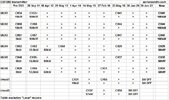Hi folks, I wonder if anyone can help me with some thoughts about this ...
I have a many-years old system which distributes signals from my TV aerial and the analogue output of a Sky+ box to half a dozen TVs scattered throughout my (large) house, using coax and a 6-output distribution box (very close to, and fed from, the Sky Box)..
The distributed DTV has always been fine, even for those TVs which have pretty long coax runs from the distribution box. However, the signal from the Sky box has, although 'usable', never been brilliant (varying, usually fairly minor, minor degrees of 'snowstorm'), even on the TV with the shortest cable run. I originally used the Sky box's default Channel of 68, but subsequently changed it to 48 ('just in case') but that altered nothing.
After many years, I've recently tried to improve the situation. Assuming that it was a signal strength issue, the first thing I tried was to add an amplifier. I tried with three different ones which I had to hand, with gains of 7dB, 12dB and 23dB respectively, and in each case tried putting the amplifier in one of three different places:
. (a) between Sky+ box and the distribution box
. (b) at the distribution box end of one of the cables from distribution box to a distant TV
. (c) at the ('remote') TV end of one of the cables from distribution box to a distant TV
Somewhat to my surprise, not only did none of these experiments (with the three amplifiers in three different places) improve the situation but, in all cases, addition of the amplifier actually considerably worsened the situation, in some cases almost to the extent of destroying the signal rom the Sky box.
I may be missing something, or not thinking straight, but I wonder if anyone has any thoughts, suggestions or advice?
Kind Regards, John
I have a many-years old system which distributes signals from my TV aerial and the analogue output of a Sky+ box to half a dozen TVs scattered throughout my (large) house, using coax and a 6-output distribution box (very close to, and fed from, the Sky Box)..
The distributed DTV has always been fine, even for those TVs which have pretty long coax runs from the distribution box. However, the signal from the Sky box has, although 'usable', never been brilliant (varying, usually fairly minor, minor degrees of 'snowstorm'), even on the TV with the shortest cable run. I originally used the Sky box's default Channel of 68, but subsequently changed it to 48 ('just in case') but that altered nothing.
After many years, I've recently tried to improve the situation. Assuming that it was a signal strength issue, the first thing I tried was to add an amplifier. I tried with three different ones which I had to hand, with gains of 7dB, 12dB and 23dB respectively, and in each case tried putting the amplifier in one of three different places:
. (a) between Sky+ box and the distribution box
. (b) at the distribution box end of one of the cables from distribution box to a distant TV
. (c) at the ('remote') TV end of one of the cables from distribution box to a distant TV
Somewhat to my surprise, not only did none of these experiments (with the three amplifiers in three different places) improve the situation but, in all cases, addition of the amplifier actually considerably worsened the situation, in some cases almost to the extent of destroying the signal rom the Sky box.
I may be missing something, or not thinking straight, but I wonder if anyone has any thoughts, suggestions or advice?
Kind Regards, John



